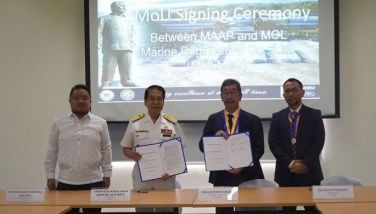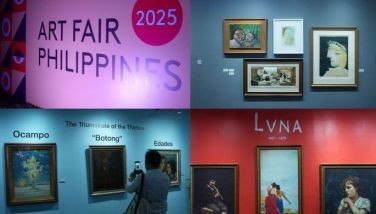"Ecological evangelization" marks 491st year of the First Mass
LIMASAWA ISLAND, S. LEYTE, Philippines – This historic island’s testament of commitment to Christian faith was manifested by thousands of pilgrims who came here for the 491st year celebration of the First Mass believed to have been held here on March 31, 1521.
What made the celebration more meaningful was the return of the Sto. Niño de Cebu since “it was brought here” by the expedition led by Ferdinand Magellan, a Portuguese explorer for Spain, on that historic time.
Augustinian priest, Rev. Fr. Tito Soquino, said the visit of the Sto. Niño de Cebu, the most revered symbol of the Catholic faithful, signified “ecological evangelization,” defined in the gospel of Pope Benedict XVI as “an expression of desire to protect the environment.”
Residents of Limasawa town and of Southern Leyte rejoiced and took pride in the big celebration they considered a triumph and an inspiration of faith. They deemed the First Mass as the seed of Christianity in the Philippines.
It was a twin celebration: Marking the 491st year of the First Mass and the first visit or return of the Sto. Niño to Limasawa. The mayor of this island-town Melchor Petracorta said the event was called “Duaw Sto. Niño Sa Limasawa: Ang Sinugdan sa Kristiyano.”
When Magellan came, Limasawa was ruled by Rajah Kulambo, who had five wives, thus the name of the island, said the mayor, adding that there was no record to show the rajah was converted to Christianity at all.
In a metal tablet, the message, engraved by the Philippine Historical Committee in 1950 and placed on the Shrine at the site, reads:
“First Mass in the Philippines: Celebrated here on Easter Sunday, 31 March 1521, when Magellan landed on this island of Limasawa on his voyage around the world. Early in the morning, Magellan sent ashore priest Pedro de Valderama with men to prepare a mass and to inform Rajah Kulambo, through an interpreter, that he and his men would land to attend. The Rajah showed consent by sending gifts. As Magellan and his men approached the shore, a salvo of six guns was fired as a sign of peace. Rajahs Kulambo and Si-Agu each embrace Magellan, flanked him and together with the sailors, they marched to the place of worship. During the Mass the Rajahs remained on the knees with clasped hands. At the elevation, the ships fired all their artillery in response to the musket signal from the shore.”
Sto. Niño’s (de Cebu) coming here last March 31 was a “kind of going back of remembering the faith,” Soquino told the media in a press conference in Maasin City, capital of Southern Leyte the day before the Limasawa celebration.
Sto. Niño de Cebu arrived in Maasin City early in the morning of last March 30, onboard a Navy boat, escorted by another Navy boat and a bigger Coast Guard vessel, led by Commodore Roberto Santos. The Holy Child was accompanied by Soquino and was received by Maasin Bishop, Msgr. Precioso Cantillas, in a procession to the church for the vigil.
The next morning (March 31), the Sto. Niño was on a Navy boat for the two-hour journey to Limasawa where, upon arrival, was greeted by Mayor Petracorta and his people riding on pump boats. Residents welcomed the Sto. Niño and the provincial officials, led by Gov. Damian Mercado and his brother Rep. Roger Mercado, the religious sector, nuns and priests and the laity.
Shortly after disembarking at the port, Cantillas said a short prayer and led the more than 2-km. procession of the Sto. Niño to the site of the First Mass celebration. Big outriggers, filled with devotees from as far as Hilongos, Leyte, landed on the other side of the island nearer the site and attended the mass concelebrated by the bishop with some 60 priests and hundreds of laymen.
Nobody really could pinpoint where the exact site of the first mass was held and where the first cross implanted, but a 6 x 8-square meter building made of Mactan-stone was built nearby to mark the site. Inside the building is a black cross surrounded by kneeling sculptures of natives and Spaniards. Paintings of the implanting of the cross, first mass, and portraits of Magellan and Antonio Pigafetta, hung around its walls.
Its 1/4 - hectare plaza at Barangay Magallanes, has been made the site of the First Mass celebration that was also highlighted by booths, representing six barangays of the island with a population of about 6,000.
The mood during the celebration was festive. Some tourists preferred to climb up the 495 steps uphill on the way to the spot believed to be where the Magellan’s cross was buried.
On top of the hill, one can have a clear view of the horizon of the Pacific Ocean eastward, picturesque mountain of Leyte province in the north and the islands of Camiguin and Bohol in the south. Up here is the black cross (the new one) replica that has become a favorite site for souvenir photos by tourists. There is no space for farming, but mahogany trees and coconuts dominate the scenery.
Bishop Cantillas said the celebration conveyed Eucharist which means “love and unity,” and that the Sto. Niño is the “admiral of the sea.”
Rosalie Licaoco, representative of Vice President Jejomar Binay who was invited but failed to attend, read his prepared message: “We have the proud legacy of being the first Catholic nation in Asia. We also have the good fortune of being blessed with two saints, Lorenzo Ruiz, and Pedro Calungsod, who is to be canonized in October of this year.”
“How can we Filipinos become better Christians? Pope Benedict XVI shows us the way in his message for Lent, when he invited the faithful to reflect on the heart of Christian life, which is charity, which in turn hinges on a biblical passage from the Letter to the Hebrews: ‘Let us be concerned for each other, to stir a response in love and good works,’” said Binay. - THE FREEMAN
- Latest
- Trending


















